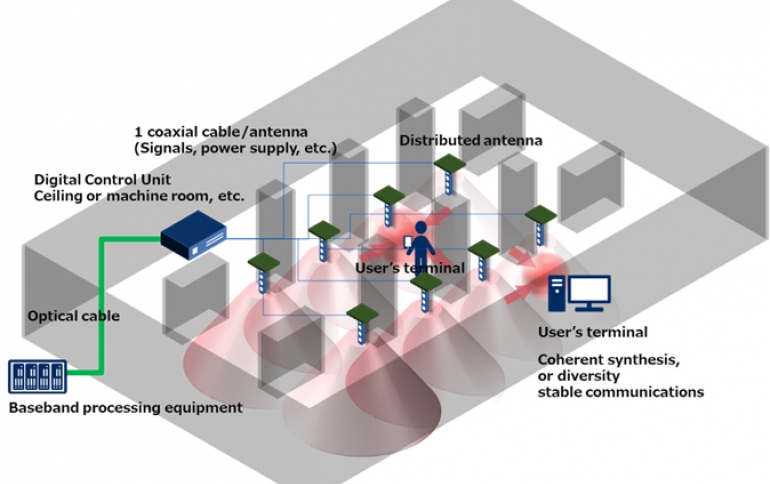
NEC Develops Millimeter-wave Distributed Antenna Radio Unit for Indoor 5G Applications
NEC Corporation has developed development of millimeter-wave distributed antennas for the efficient use of 5G millimeter-wave spectrum (28GHz band).
Demonstration experiments were conducted with this technology at the NEC Tamagawa Plant in 2019, where the capability of high-speed, large-capacity communications with stable propagation channel quality were confirmed.
In terms of background, 5G uses millimeter waves, which have frequency bands more than 10 times higher than 4G, and are expected to contribute to a wide range of services that provide high-speed, large-capacity, low-latency, and multiple connections. Compared to sub-6GHz, challenges at the millimeter-wave level include large attenuation per distance and attenuation by shielding due to shorter wave length, divergence difficulty, and the large influence of reflection and intervention. As a result, it is necessary to establish a large number of base stations to ensure communication quality. However, in places with limited space, such as homes and workplaces, there is also a need to downsize base stations.
To resolve these challenges, NEC developed digital coordination technologies to connect distributed antenna elements for wireless satellite stations (RU: Radio Unit) of 5G millimeter-wave (28GHz-band) base stations. Moreover, NEC says it resolved the issues of shielding and diffraction of propagation paths for interior mobile communications using millimeter-wave communication. This technology applies NEC's proprietary massive MIMO, which combines a large number of independent antennas, in order to deliver millimeter-wave high-speed, high-capacity communications with stable communication quality.
In addition, by connecting distributed antennas to control units using a frequency multiplexer that consolidates multiple signals, NEC resolved issues related to attenuation, synchronization and power supply that might arise when connecting antennas and control units with high-frequency cable or optical cable, thereby helping to facilitate the installation of antennas. Furthermore, NEC has produced smaller antennas (approximately 5cm×2cm with 8 components) by designing and implementing circuits cultivated through NEC's iPASOLINK microwave communication system.
NEC's demonstration experiment consisted of a system with eight antennas, a control unit for controlling antennas, and a baseband processing unit that controls antennas.
In the experiment, NEC applied digital beamforming, which had been developed in the sub-6GHz and millimeter bands, to 28GHz band antennas. Digital beamforming is a technology that focuses on a particular direction by spatially combining and multiplying radio waves. This reduces radio interference between the base station and the terminal, thereby providing a more stable radio wave.
By combining and multiplying the space of radio waves, NEC says it achieved not only high-speed, high-capacity communication, but also stabilized the propagation path. NEC also achieved stable communications in difficult propagation environments, such as shadowing by walls, interference from reflective waves, and environments where multiple terminals are closely linked.
Going forward, NEC will continue to conduct demonstration tests in various environments, such as office buildings, commercial facilities, and factories, with the aim of commercializing this technology by the end of 2020.





















